If you like title sequences, then be sure to watch this showreel by London based studio Momoco featuring their work on Bridgerton, Cursed, The Gentlemen and many more:
© Vincent Frei – The Art of VFX – 2021
If you like title sequences, then be sure to watch this showreel by London based studio Momoco featuring their work on Bridgerton, Cursed, The Gentlemen and many more:
© Vincent Frei – The Art of VFX – 2021
Nathan McGuinness has over 20 years experience in visual effects. He founded the studio Asylum in 1999 where he has worked on films such as Pearl Harbor, Black Hawk Down, Pirates of the Caribbean: At World’s End and The Curious Case of Benjamin Button. When Asylum closes in 2011, he joins the DNEG team and has worked on projects such as Battleship, Total Recall, Furious 6 and Westworld.
Pete Bebb started his career in visual effects more than 20 years ago at DNEG for the movie Pitch Black! He then worked on a many films including The Chronicles of Riddick, The Dark Knight, Captain America: The First Avenger and Fantastic Beasts and Where to Find Them. He won an Oscar for Best Achievement in Visual Effects for Inception.
How did you and DNEG get involved in this show?
Nathan McGuinness // Aaron Ryder, Executive Producer at FilmNation who I have worked with on several projects in the past reached out as a 911. The project was in need of help not only from a visual but also a storytelling standpoint. The combination of helping create both story and vision excited me.
Pete Bebb // Mike [Chambers, VFX Producer] and Nathan are old friends to DNEG and they reached out to us to complete this show which was in trouble due to problems with a previous VFX vendor. The reliance on CG for narrative was significant and time was of the essence, and we saw it as a real challenge, not only from a logistical standpoint but also a creative one. Plus who in their right mind would turn down a Tom Hanks war film!
How was the collaboration with the filmmakers?
Nathan McGuinness // I had a very close and personal creative working relationship with Gary Goetzman, Producer Playtone, Tom Hanks, Writer / Main Character “Captain Krause” and Aaron Ryder, Executive Producer, FilmNation. My home base was at Playtone so that we were able to closely collaborate every step of the way during the create and storytelling process.
Pete Bebb // From a DNEG standpoint we predominantly dealt with Nathan and Mike. Nathan obviously liaised with the studio to be sure we were creatively on the right track and on target to deliver.
What were the filmmakers’ expectations and approach towards the visual effects?
Nathan McGuinness // The filmmakers were looking for a seamless photoreal environment to build the story of Captain Krause and Greyhound’s journey / battle at sea. The filmmakers looked to me for guidance to create environments not captured in camera given my extensive background in creating brutal battles environments at sea.
Pete Bebb // At the point we joined the production, the filmmakers had not seen much from VFX, hence the reason for us being approached to do the show. Consequently, once sequence layout, asset look development and early water FX tests started to come through it was all very much welcomed. Both Nathan’s and our approach were in tandem, very keen to keep the camera real world and the look authentic. For us this m/o was imperative. The fact they are visual effects shots should really bear no significance. If we have been involved from the start we would have no doubt approached shooting as much as we could in camera.
How did you organize the work between you two and your VFX Producer?
Nathan McGuinness // Mike Chambers, VFX Producer, not only managed the vendor – which given the schedule was an insurmountable task, he also was intricate in creating an environment where I could pre-vis, post-vis, edit, collaborate with sound design and color in order to streamline Greyhound’s journey that the VFX was able to create.
Pete Bebb // Regular video calls with Nathan and Mike happened most days as we structured a plan of attack for this show. In the meantime data was being requested from the previous vendor to aid in our workflow, but with time being limited there was a point by which this task was rendered redundant.
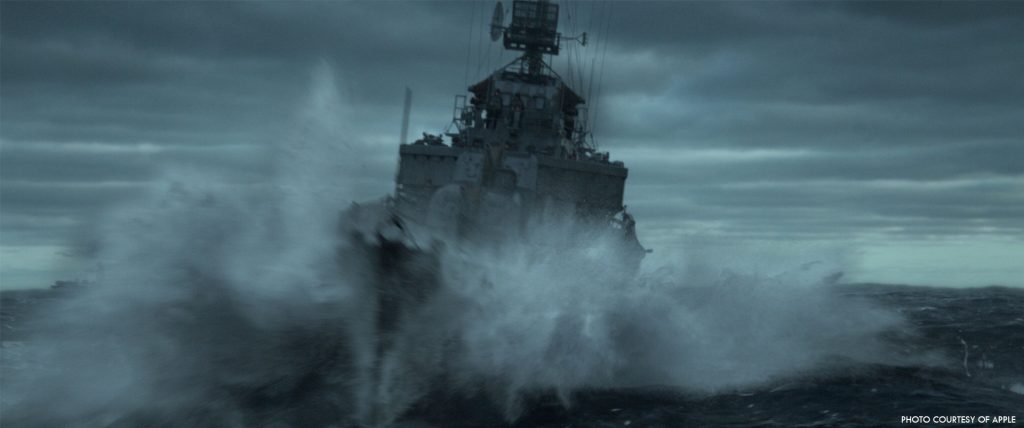
How did you split the work amongst you and the DNEG offices?
Nathan McGuinness // From my point of view I oversaw DNEG as one Vendo
Pete Bebb // From a DNEG perspective our London studio developed the look, lighting and FX for the show. Hero shots and set-ups were taken to final and then the ‘recipe’ so to speak, was sent to various DNEG offices around the world for execution.
The movie is taking place almost entirely on the ocean. What was your approach?
Nathan McGuinness // My first process was to re-create the path of Captain Kraus, The Alley Convoy as well as the German Submarines. I visualized their realtime nautical path and broke it down into multiple beats creating the storyline; environments / time of day / weather /battles /convoy tactics…. Once I had the full journey visualized I brought in a previs team to reenact a geographical chart of the number of ships and their path which was crucial because of their constant course correction during their journey across the Atlantic, knowing that each turn presented a different environment; sun, sea, horizon, boat position etc. Also of utmost importance was the choreography of the confrontations between the Grey Wolf, it’s Wolf Pack and the Greyhound. Gordon Laco, who was the naval consultant whom I have worked with previously, was key in helping setting the scenes to be true to history!
I also did a deep dive to catalogued old photography, film, voice recordings from WW2 creating an extensive library for reference making sure what was recreated was true to the event. As we were creating non existing plates I looked at each shot as if we were filming at sea – that vision along the pre-vis and the library I created for look development I was able to give clear creative direction. With the above mentioned combined with DNEG’s Sky Capture photography I was able to go shot by shot selecting an accurate time of day to hand hand off HDRI’s in order for DNEG to light accordingly. This was our foundation.
Pete Bebb // In light of time available, shooting any plates for this was long gone. The approach had to be full CG for the ocean and ships to allow us the flexibility and power to create multiple shots of guaranteed quality. The plates from New Orleans of the dry dock USS Kidd were good but we had a challenge to get the lighting to fit and of course ocean interactivity. Storms in the Atlantic tend to be far greyer and miserable to that of the New Orleans climate.
From extensive research and reference from Nathan and his team (including a naval advisor) we went about building various hero escort vessels and the convoy. What data could be retrieved from the previous vendor was utilised, but a lot had to be started from scratch to be compatible with our in-house pipeline.
Due to the nature of the film being a minute by minute account from the perspective of the Captain we knew we had to have weather that worked with each scene and flowed. Knowing this we used a bespoke system from DNEG called Sky Capture. Basically this is 10 stills cameras arranged in a hemisphere set up to record HDR images every few minutes. This system creates a very high resolution HDR time lapse footage that we used to light the various scenes. We sent teams to the coast around the UK so we could try and gain as much clean horizon photography as possible. A clean horizon line being key for the environment at sea. From these various lighting and sky captures internal selects were made for each scene and offered to the client for approval. Once Nathan was happy we developed a look for each sequence based off this set up. The ocean development was worked up in conjunction with this. Nathan advised us as to what level of Beaufort he wanted per scene. Ranging from Beaufort 2-3 all the way to 7-8. Beaufort scale determining the ocean conditions. A total of 5 ocean Beaufort scales were created.
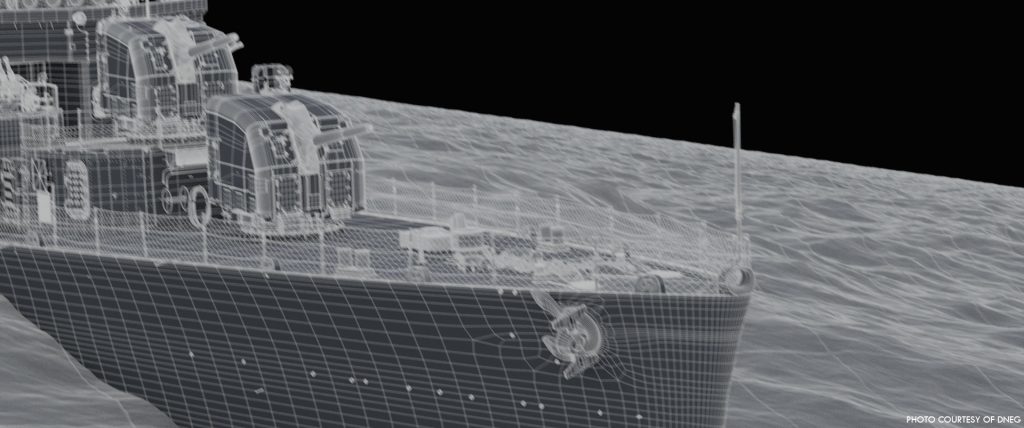
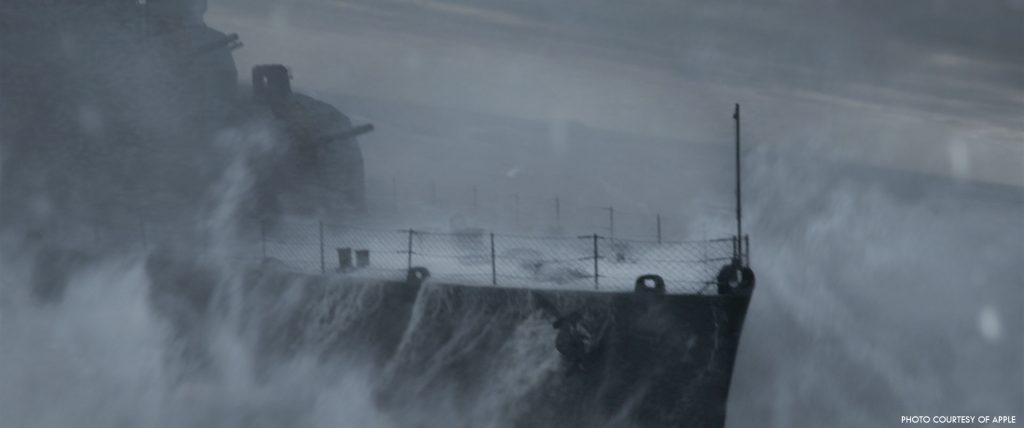
How did you use the Previs to organize the shooting and the post production?
Nathan McGuinness // I was not involved in the shooting process and there was little to nothing to use from it. My use of previs is explained above.
Pete Bebb // None of us including Nathan and Mike were involved in the shoot. Thus we did not have the opportunity to utilise previs through to techvis to design the shots. What you would typically expect from a VFX perspective from a shoot was not undertaken to our knowledge, rendering our job that much more difficult.
From a post production point of view we did undertake previs to design shots taking the approach of real camera work – boat to boat scenarios. Nathan was keen to maintain this level of realism as were we. Camera design is critical to the believability of this type of film.
In addition to this we used the beat by beat radar plans issued by production under the remit of the naval professional to determine the course of the scenes and how exactly the escorts convoy and U boats would react in certain scenarios. We mocked out all of these plans into one master scene in layout thus giving us shot by shot account for the entire film. You could essentially watch the entire film from a birds eye view.
Many shots are full CG. Were you able to submit ideas and suggestions for the Framing?
Nathan McGuinness // This was such an important part of my thought process. I put myself within each scene – man vs nature visualizing the POV; out sea, ship to ship, birds eye view, visuals of seaman and the german U-boats creeping under the ocean depths at sea. Seeing through Captain Krause eyes and researching scenarios was of utmost importance.
Pete Bebb // Yes absolutely – we designed certain shots based off how they may have been shot in the day. Ship to ship essentially or from a plane.
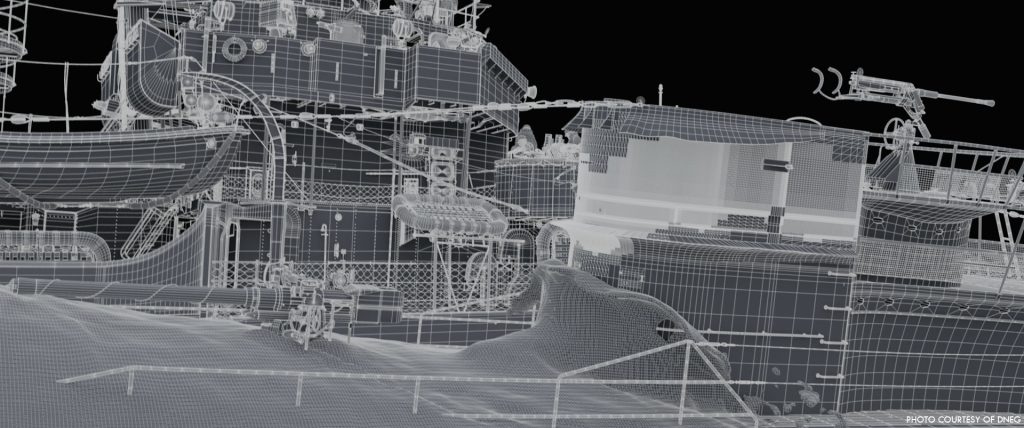
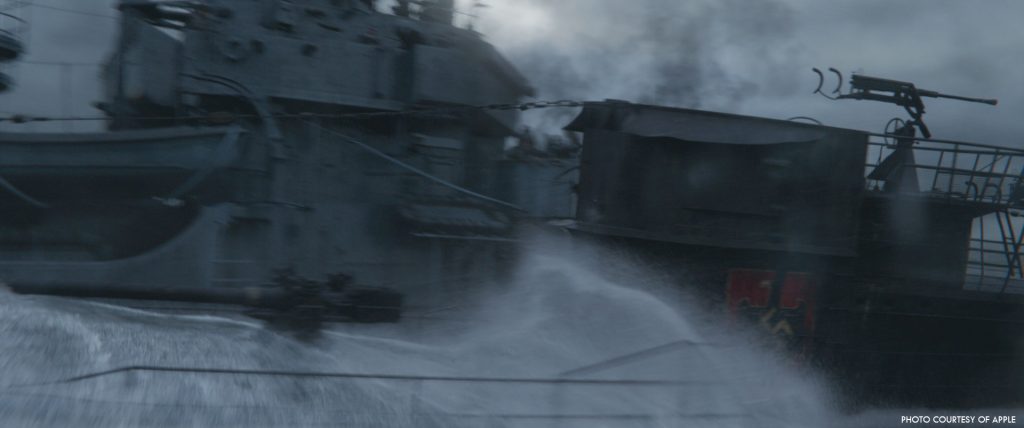
Can you elaborate in detail on the ocean creation and the water simulations?
Nathan McGuinness // I began researching real photography to represent the character and vengeance of the water for each scene (Beaufort scale). I provided the photography as a guide to match the temperament of the ocean for each shot. Providing Pete with visual’s of what was in my head enabled him to provide his FX team with a plate to recreate.
Pete Bebb // As discussed earlier we worked closely with Nathan on finding the correct lighting first and then we went about assigning the various Beaufort scales per scene. Once we had established what was required from a narrative standpoint we went about trying to find reference for ocean conditions as hero material to match to. We found some excellent material, one clip can make all the difference for an FX team to match to. This was an ongoing process showing the client all the way through post, both standalone in an lookdev scene and of course in hero shots too.
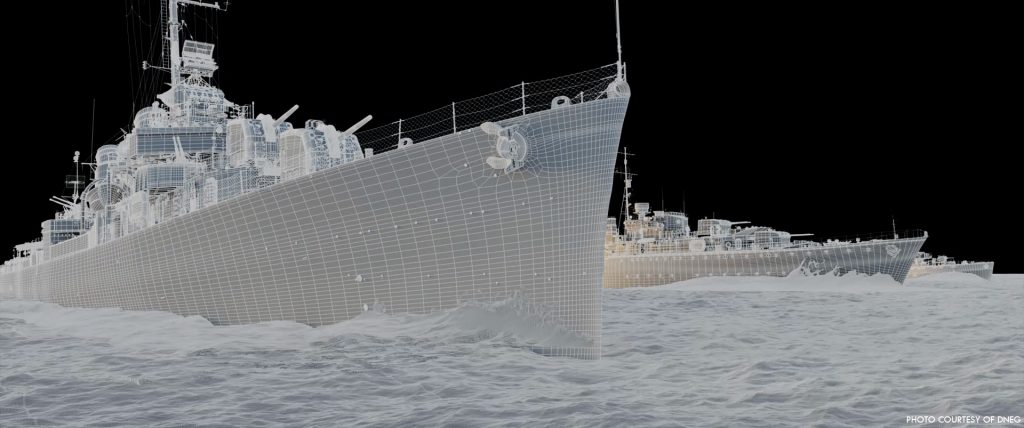
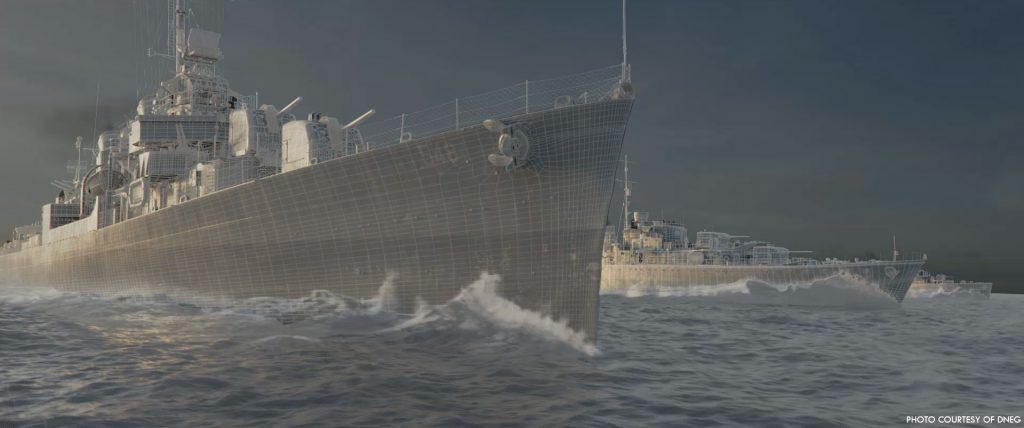
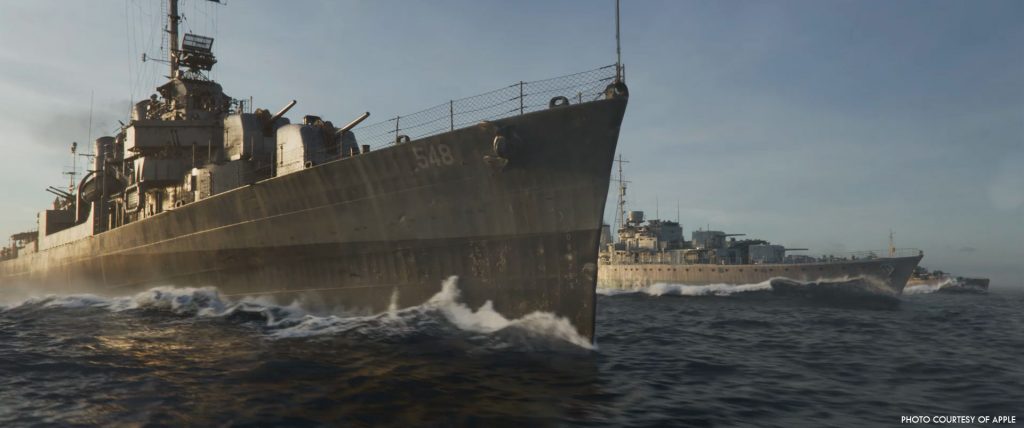
How did you prevent your render farm from burning?
Pete Bebb // From day one on this show we were very aware of the time. Consequently pipeline and shot methodology were critical. We designed an entire new layout pipeline that allowed us to procedurally run matchmove cameras directly into an animated and lit scene to render it. This could also be automated to run through a sequence comp script to give us an entire shot or sequence for dailies the next day. This type of automation ran through multiple areas of the film to allow us to streamline the process. To aid in settling the look of the film we broke down the entire show via shot type. Categorising the level of difficulty of all of them. Then we chose a shot category from each sequence and fast tracked it to final. This then gave the crew a shot to match to for all other similar types of shot with a given sequence. For example; there are scores of shots looking out at the bow crashing into the water from the bridge. Once one shot was fast tracked the rest were matched to that final
Can you elaborate on the creation of the various boats, planes and of course the U-boats?
Nathan McGuinness // There was no formula to recreate the Plane, Boats and U-Boats! In depth conversations with Gordon Laco (Naval Consultant) and the filmmakers and again, a ton of research to catalog the build and destruction of the Planes, Boats and U-Boats cherry picking the most specific ships / planes for the hero shots. We were very respectful not to overlook the DNA of these magnificent vessels.
Pete Bebb // Some data came from the previous vendor eventually – images and some lidar scans – but most was good old fashioned research from both ourselves, Nathan and the Naval Advisor. Old school means of undertaking CG asset creation. We thought it would be apt to go and have a group visit to the HMS Belfast at London Bridge – to understand the scale of these vessels but also the level of detail and construction of them. We also learnt Morse Code too! 😉 The build of the hero vessel the USS Kidd (Greyhound) was a huge undertaking which took literally the duration of the show to complete. The shots were continually being updated with the latest asset to make the most from the improvements the team had made. By the time the asset was finished you could graze the entire exterior structure to within a few inches. It was a phenomenal asset. This is reflected in the opening shot.
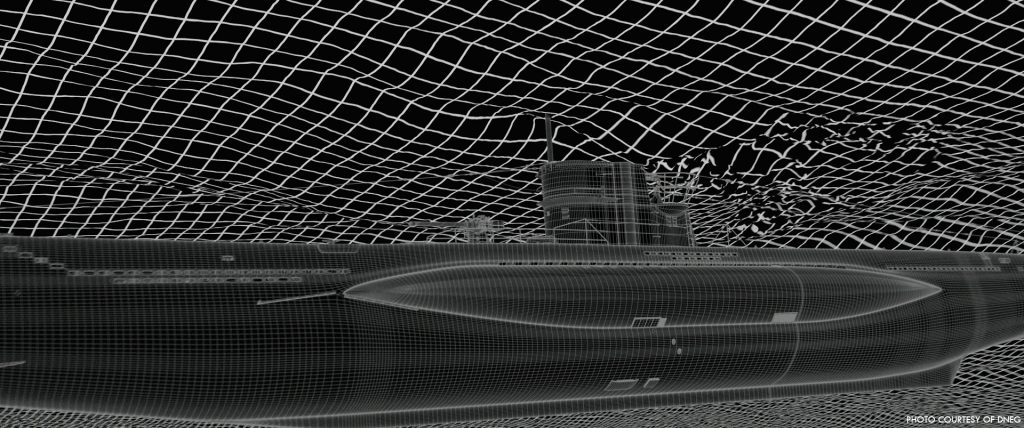
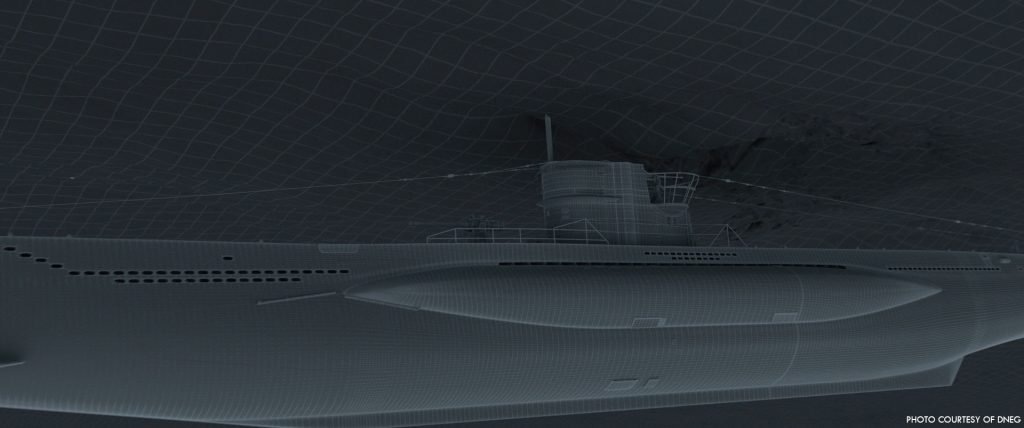
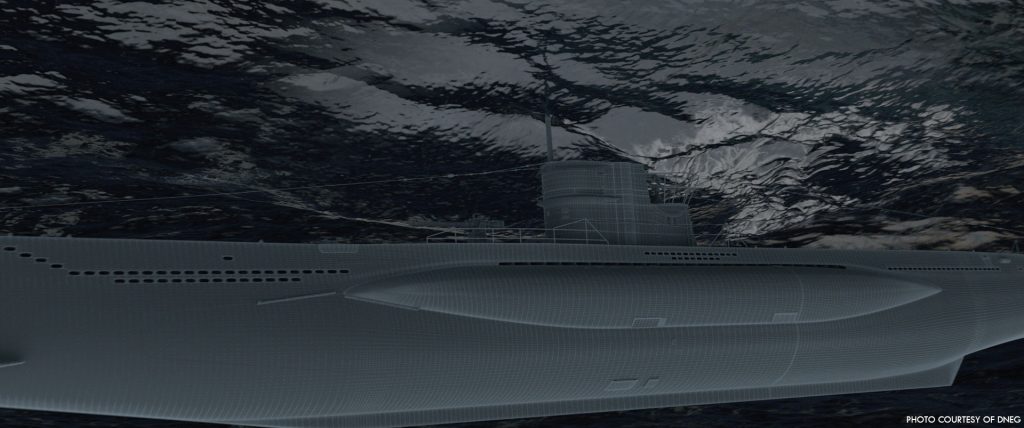
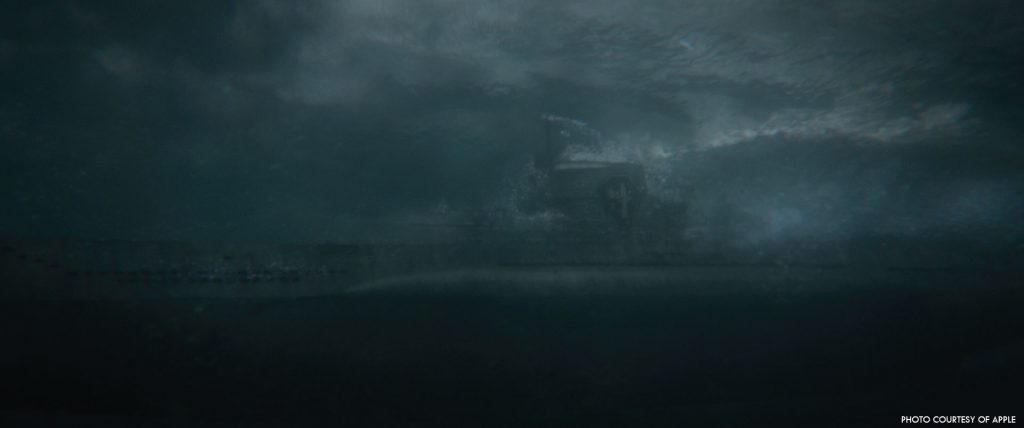
How did you create the various shaders and textures?
Nathan McGuinness // Researching and collecting photography of various degrees of aging, damage, color schemes, lighting iteration to oversee the skin of the vessels in every phase of their journey.
Pete Bebb // Textures were created via multiple means from shooting the real USS Kidd to assessing the light on the HMS Belfast. A lateral thinking approach had to be undertaken for this task as not being part of the original VFX crew we did not have the usual amount of data we require.
How did you populate the boats with crew?
Pete Bebb // Some crew was shot against greenscreens on a 1.1 buck build. We did get that from the production but then we had to build some digi doubles to allow for mid/wide shots. There was a limited reliance on CG extras as the budget did not allow for this. No hero Tom Hanks for example. It is a better film for it in my opinion – I am not a huge fan of digi-doubles.
Can you tell us more about the various explosions?
Nathan McGuinness // Again live footage as reference was key! There is a big difference between the way a merchant ship carrying certain supplies e.g fuel explodes compared to a merchant ship carrying food supplies. Also the location of impact, first and secondary explosions; day vs night explosions. Explosions caused by guns firing from the destroyer vs depth charges would react completely differently. The german U-Boat with their torpedoes had a life of their own. Each explosion had its own beautiful aesthetic. Especially at night given there was almost zero visibility until… boom!
Pete Bebb // Explosions are all CG with reference to real war footage for the specifics. For example; the muzzle flash of a Bofor gun was matched to for period accuracy. For the main explosions we referenced both stock footage and the DNEG explosion element library. A combination of the two. For the most part though we matched to stock – actual filmed footage of depth charges matched in FX and then signed off in side by side comparison for the client. This methodology was conducted across the board for all explosions and ordnance.
How did you handle the lighting challenges especially for the night sequences?
Nathan McGuinness // The only way for the convoy to travel undetected across the Atlantic safely at night was in total darkness. Not even a cigarette was allowed to be lit! It was a bling game of chess. I sat in the dark imagining the strategic game played – a game in the dark which had to be translated for the audience. The moon being the main source of light we designed a shots
Pete Bebb // As before the HDR time lapse material set the tone and real world environment. This was physically correct. But as you can imagine the actual illumination at night in the middle of the Atlantic is minimal. It is basically the moon. This obviously presented some problems from a narrative perspective. We want this to be completely visceral and real for the subject matter but we also want to be able to tell the story and actually see the ships. It was a dilemma. Escorts did clip convoy vessels, this actually happened under wartime black out conditions. Nathan mentioned you could be in serious trouble as a sailor for having a cigarette out on deck for example. So this gives you some idea of just how dark it was.
Of course we first created the scenes like this, very true to the environment and wartime scenario. They were brutally real, very dark and immensely atmospheric with what you could not see. What was decided though was to increase the moon contribution by a half stop to a stop in the shot so DI could then have something to play with. Of course the reliance of external lighting sources was key too, flares, explosions, tracer fire all lit the scene in a way that was very authentic. It was a very enjoyable experience developing the night time look as it was for the day time too.
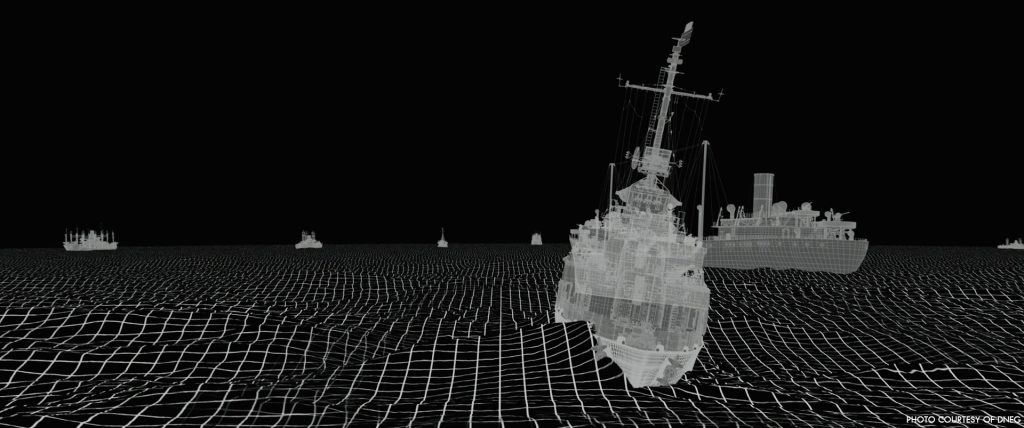
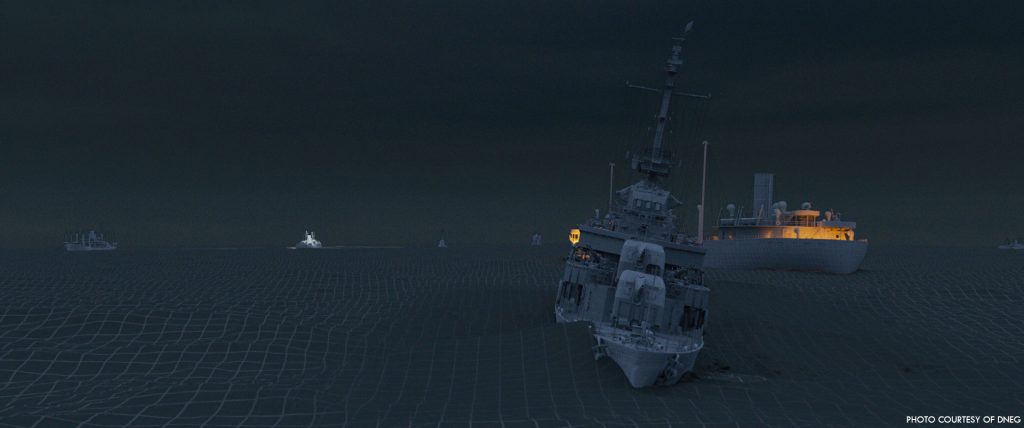
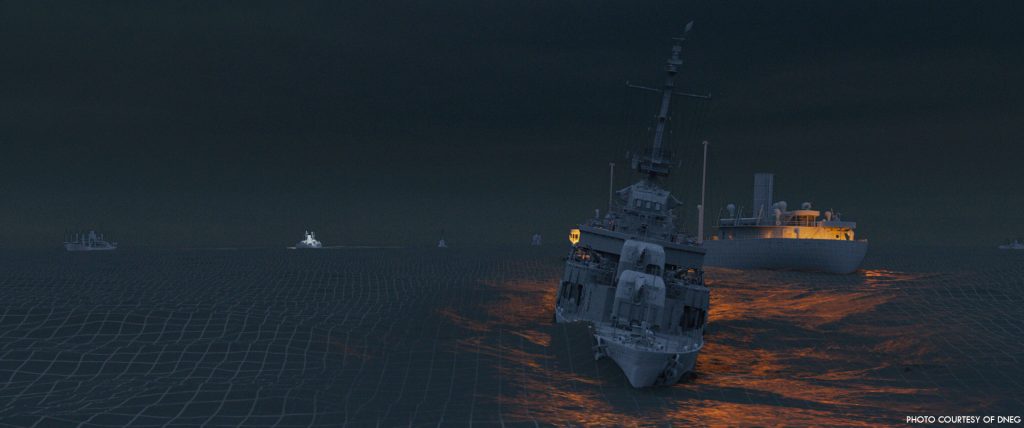
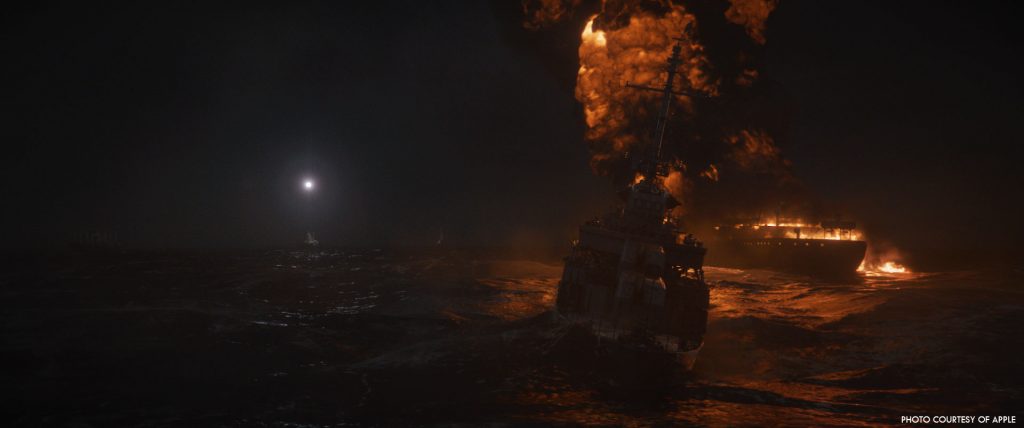
What were the main challenges with the underwater shots?
Pete Bebb // In a similar way to creating the night time look the underwater look was also a challenge. The challenge was the physically correct versus the narrative. At night under water in the Atlantic you’d see barely anything – a few meters ahead if that. But we need to see the U-boats launch torpedoes, we needed to see what U-boat it was etc. We opted to use more environment light from above, from explosions to ambient moonlight. Any means from a literal physical based source.
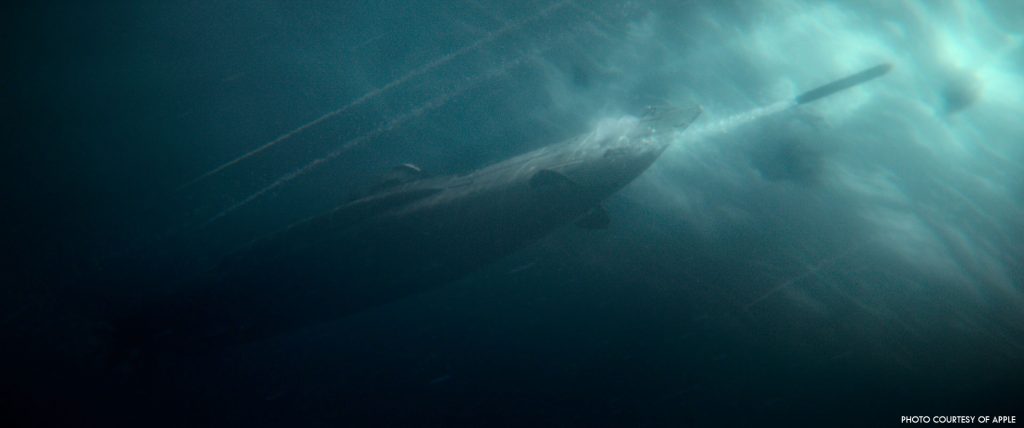
Some shots are really long. How does that affect your work?
Pete Bebb // It only affects the turnaround from a logistical point of view, increased animation time, increased simulation time and increased render time etc. Basically all departments are affected. But we incorporated the stages system on this show and instructed the client that we had to adhere to it to complete on time. So once approved at each stage there was no turning back. Stages being layout, anim, FX, final cg comp etc..
Which sequence or shot was the most challenging?
Pete Bebb // There was no specific sequence for me or shot. The entire show was a challenge from a time aspect and maintaining authenticity and quality. That is also what made doing the job so much fun.
Is there anything specific that gave you some really short nights?
Pete Bebb // We handpicked the DNEG crew for this one, I would like to say they are the A Team. So there were no real worries, but just real challenges that we knew we could overcome. The prospect was slightly ridiculous in hindsight. Approximately 1500 shots with full CG environments with no assets and no time. What more do you want to keep you on your game? When the scenario is this challenging all you can do is knuckle down.
What is your favorite shot or sequence?
Pete Bebb // PBO_0270, see I even remember the shot name. Wide angle lens on the bow of the ship as it fires its 5inch guns directly into camera. Looked great. I am also very partial to the bow wave crashing shots from the bridge. They just looked like the period footage, cold, overcast and slightly daunting. Just a huge shame that it was never released on the big screen. This show was shot for it.
What is your best memory on this show?
Pete Bebb // The client and the team. Forgive the pun, but it was an ‘all hands on deck’ adventure that paid off. What more do you want in this job.
How long have you worked on this show?
Pete Bebb // First introduced to the client in October, we delivered the show in February with some additional last minute shots going into March. The majority of the 25 sequences, approx. 1500 shots, were undertaken in under 4 months.
What’s the VFX shot count?
Pete Bebb // Approximately 1500.
What was the size of your team?
Pete Bebb // Approximately 500+ but I do not have exact numbers. I had teams in Mumbai, Vancouver and London.
What is your next project?
Pete Bebb // Infinite with Mark Wahlberg and directed by Antoine Fuqua.
What are the four movies that gave you the passion for cinema?
Pete Bebb // The Empires Strikes Back. Dune. Alien. Jaws.
There are far more than that of course….the list goes on…
A big thanks for your time.
Greyhound – Behind the Scenes VFX Breakdown – Apple TV+
WANT TO KNOW MORE?
DNEG: Dedicated page about Greyhound on DNEG website.
Apple TV+: You can watch Greyhound on Apple TV+ now.
© Vincent Frei – The Art of VFX – 2021
Let’s go for an epic and magical journey with this trailer of Raya and the Last Dragon!
The Animation and VFX are made by:
Walt Disney Animation Studios
Directors: Don Hall, Carlos López Estrada, Paul Briggs, John Ripa
Release Date: March 5 (USA & Disney+ Premium Access)
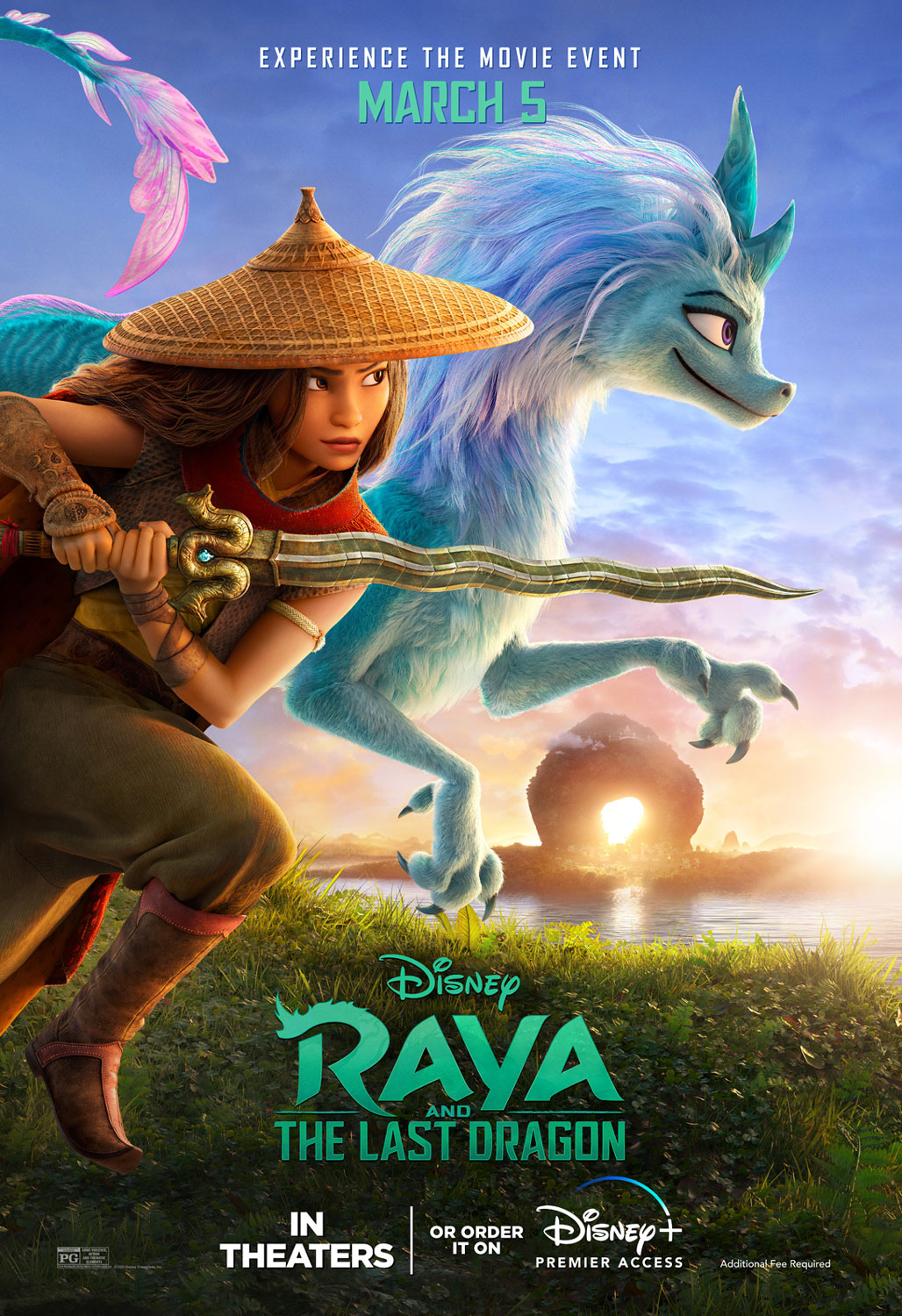
© Vincent Frei – The Art of VFX – 2021
The creative teams of The Watch are taking us for a tour on the set of this BBC fantasy series based on Terry Pratchett’s Discworld:
© Vincent Frei – The Art of VFX – 2021
Prior to the publishing of our interview tomorrow about Greyhound, Apple TV+ offers to us this really cool VFX Breakdown about the work of DNEG:
WANT TO KNOW MORE?
DNEG: Dedicated page about Greyhound on DNEG website.
Apple TV+: You can watch Greyhound on Apple TV+ now.
© Vincent Frei – The Art of VFX – 2021
Let’s have a look at the variety of the work made by Glassworks on Movies and Series such as The Crown, Black Mirror, Outlander and A Monster Calls:
© Vincent Frei – The Art of VFX – 2021
Let’s go for a trip to the North Pole with Weta Digital about their work on the Netflix movie, The Christmas Chronicles 2:
WANT TO KNOW MORE?
Weta Digital: Dedicated page about The Christmas Chronicles 2 on Weta Digital website.
Weta Digital: My interview of the Weta Digital team about The Christmas Chronicles 2.
Netflix: You can now watch The Christmas Chronicles 2 on Netflix.
© Vincent Frei – The Art of VFX – 2021
Let’s have a look at the invisible work made by Chinese studio Free-D Workshop on Ip Man 4 – The Finale:
© Vincent Frei – The Art of VFX – 2021
Russell Dodgson has been working at Framestore for over 10 years and before taking care of the visual effects of the His Dark Materials series, he worked on projects such as Harry Potter and the Deathly Hallows: Part 1, Black Mirror and Mars.
What is your background?
I originally come from a commercials background and was the Global Head of the Nuke department in Framestore’s Integrated Advertising division for several years. I eventually took on the challenge of working with a small group at Framestore to restart the company’s episodic division around 6 years ago.
What was your feeling to be back on the second season of His Dark Materials?
It always feels great to regroup with a team you are so fond of, it feels like getting the family back together. It was a slightly unique case on His Dark Materials because we knew the second season was greenlit before we started shooting Season 1. The team really wanted to maximise the age range of the Dafne Keen and Amir Wilson so there was a really rapid turn around between the two seasons. In the end we were prepping and beginning filming on Season 2 whilst still delivering Season 1.
How was the collaboration with the Showrunners and the directors?
His Dark Materials has a really collaborative spirit so the experience is always very rewarding. We had the benefit of Jamie Childs returning after Season 1 as our lead director alongside the brilliant Leanne Welham. I work closely with the directors (around the busy shooting schedules) to help plan the best VFX moments we can. We spend time working out how we can execute these moments on set within our schedule and budget. This process is supported by Dan May and his team at the Painting Practice who create the show’s awesome concept art as well as working with us to build out the ideas in previs and postvis.
VFX is such a central piece of the series so the collaboration with the showrunner and the producing team has to be really strong. We spend a lot of time working out where the VFX budget is best used to support the narrative in general whilst also crafting the correct moments to punctuate the episodes with set pieces.
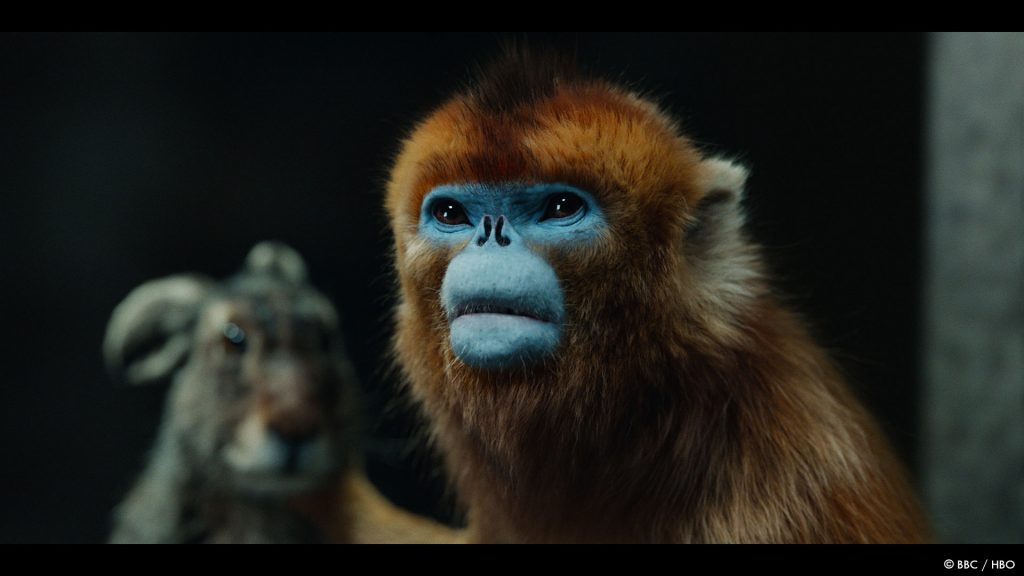
What were their expectations and approach about the visual effects?
We all know there is never enough money to do everything you want, even if the money was five times greater our ambitions would grow to exceed that and we would be back where we started. We had already answered the biggest VFX question of the show “what will the daemons be like?” Between the amazing work by the team at Framestore, the brilliant onset puppeteering and the great performances our principal cast gave us to animate to, we certainly exceeded the expectations for the show’s creature work. The real question of Season 2 was how we keep the feeling of season 1 with a story that shifts tone, location and rhythm so much. Season 1 was more of Lyra’s Odyssey and she travels through new, very different, locations every episode. Season 2 is much more about telling the story between repeating locations across different worlds. We also, to a large degree, lose the bears but replace them with new things. So the main challenge was maintaining the scale of the show but with different ingredients.
What are the main changes that you did since the first season?
To be honest it was very much business as usual as one season flowed straight into the next from a VFX perspective.
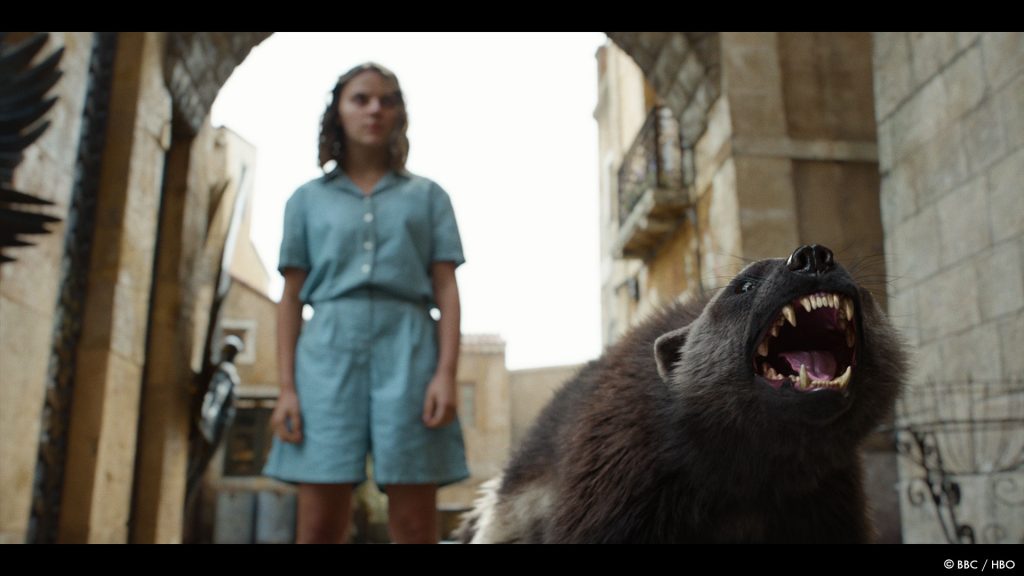
How did you organize the work with your VFX Producer?
We have an amazing VFX production team on both the client side and the Framestore side. Client side I work with James Whitlam and Bryony Duncan along with the rest of our incredible team to break the show down into manageable pieces. When VFX shows get to a certain size you start having to bid in averages as much as at the shot level and they do an exceptional job at that. I tend to go through the scripts and do a “creative pass” where I direct it in my head, ideally with a knowledge of the style of our directors, and turn this into shot counts. At the same time James and Bryony break it down and then we compare numbers and amend, doing it this way really helps as we are “kicking the tyres” on the bid as we go. It is always a bit of a shifting target and so requires cool heads and a robust process.
How did you split the work amongst the Framestore offices?
We always try and keep parcels of work within certain offices to keep the number of split shots to a minimum. Framestore has an excellent multi-site pipeline that facilitates the splitting of work, but even with the luxury of that it is better to keep whole shots with one group of artists where you can. In the end we did a bit more work in London than in Montreal but they were both responsible for delivering some of the shows biggest scenes. London once again took all the Golden Monkey work but was also responsible for the build of Cittagazze and the development and execution of the Spectres. Montreal were responsible for all of our Witch set pieces such as Ruta flying through the storm and attacking the submarine in episode 1. They also created and animated the asset of Pan as a Red Panda which was an exciting new addition and revisited Iorek in episode 3. We also split some parcels of work to some of our other teams. A large sequence in Episode 7 went to our great team in NY and the the observatory sequence and a few others yet to be aired were crafted in our IA team in London, they were also responsible for creating the Lemur asset in episode 3.
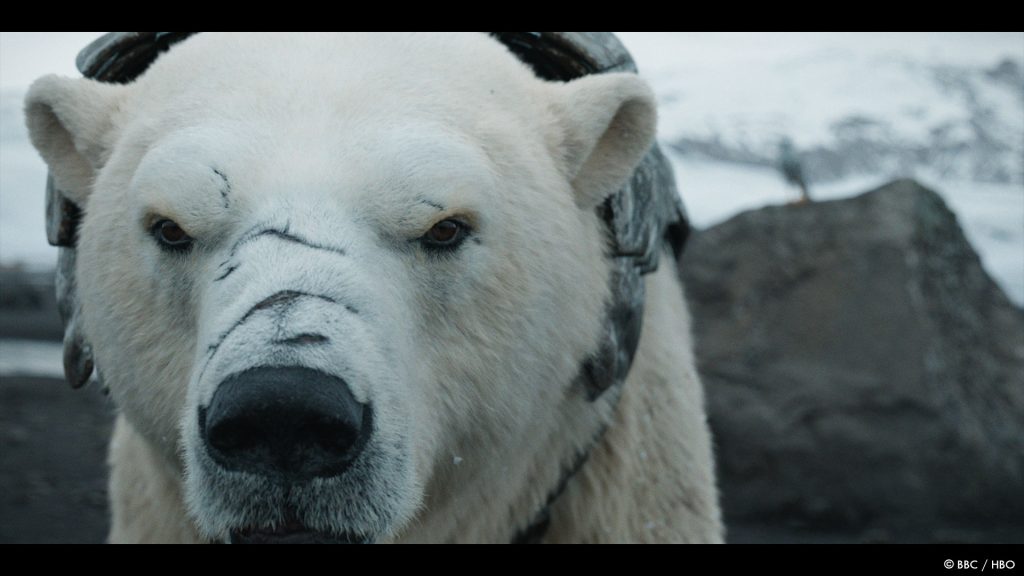
This new season opens in the beautiful city of Cittàgazze. How did you work with the art department for its design?
Joel Collins and the team at the Painting Practice did a lot of work designing the city both internally as well as it’s overall look and feel. They designed it from the overall shape and layout to the iconic staircases that run through the city and the details in the railings and plaster work. Dan and his team at Painting Practice created a version of the town in the Unreal engine which allowed us to quickly see how the shape held up from all angles, heights and distances. Joel always wanted the city to be surrounded by a grand mountainscape that rose from the ocean; at first he was inspired by the mountains in Guilin but then our VFX producer James Whitlam suggested Kauai as he had visited there previously and the Napali coastline offered a perfect subject. So I travelled out there with our plate unit DOP Paul O’Callaghan and we did several days of helicopter shooting as well as some general travelling shots for Lyra’s journey to the city from the Anomaly. Once we returned, Dan and his team then integrated the landscape into the concepts. By the time we got to turn over the concepts team had created a base massing model and a pack of low poly buildings as a guide for the team at Framestore.
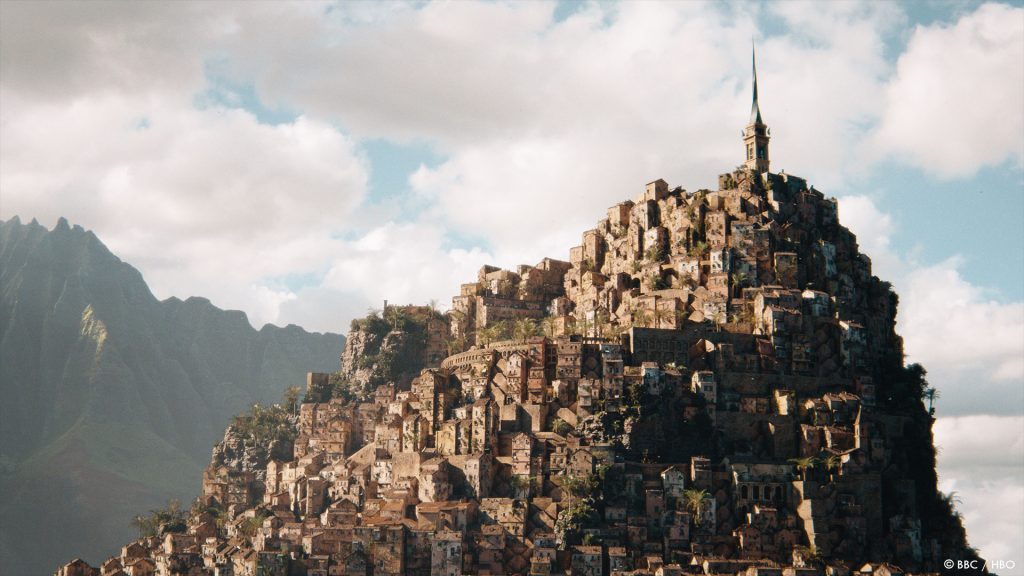
Can you explain in detail about the creation of this city?
Even with all the aforementioned planning and conceptualisation, when dealing with an asset of this scale there is never enough information. Rob Harrington and the environments team led by Deane O’Keefe went to work turning the low detailed design asset and individual buildings into something that looked real both in terms of detailing, shape and texture. Houdini was then used to procedurally add windows, balconies and other details and then final distressing was performed manually in Maya. The shading for the building was a mixture of substance and procedural textures. The team also had to integrate and match the portions of the town that were built for real, the practical set was highly detailed, so they needed to balance recreating that with render efficiency. We use Lidar extensively on set and in post so the high res backlot Lidar was retopologized in Maya and ZBrush. Side FX Houdini was used extensively for layout and scattering of props and rocks. The exposed rock faces were created procedurally in Houdini, trees, vines and plants were crafted from reference in Speedtree and the animation baked in Houdini. In the end the city is made up of over 430 bespoke models which were instanced over 3,380,000 times to create the city. The last stage of shot execution then uses a final beauty paint technique to add final details.
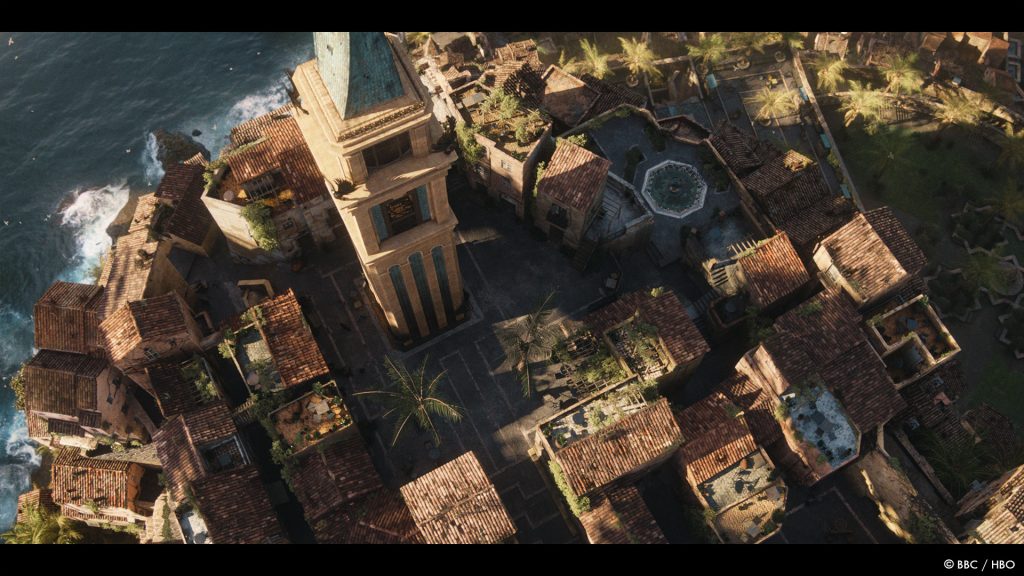
The terrifying Spectres are one of the new threats in this season. What were your references and influences for them?
The Spectres offer up a slightly unique challenge as they aren’t really monsters, they didn’t once live, they don’t speak or eat, they just devour peoples humanity in an impartial way. A lot of the challenge is trying not to be derivative which is hard now so many brilliant, spooky, FX driven monsters have already been brought to screen. We knew that our showrunner Jane Tranter didn’t want the Spectres to be completely black and shiny and they definitely didn’t want a tangible front and back. I referenced underwater creatures a bit but had to make sure we didn’t go too far down that aesthetic route.
Can you elaborate about their creation and the animations?
Due to our fast schedule the FX team opted for a procedural route using Houdini. This allows for a relatively speedy asset development but makes shot execution less predictable (which is the cost). The procedural approach makes the creatures less art directible but leads to some really interesting and often unexpected results. We had a very simple lozenge as our animation proxy that gave us timings, position and rough volume. This was then run through a series of layered procedural simulations that give us the various textures and movements within the Spectres.
The heroes found The Subtle Knife. Can you explain in detail about the FX work when they open a portal for the other world?
This was one of the show’s other challenges. Firstly we had to come up with an aesthetic and logic. We had already set the tone for the way that the journey between worlds and the fabric of the universe is based around “strings”. This was in the finale of season 1 and is in the titles in a big way. The complex thing is that the instrument that cuts them is called the “Subtle Knife” because it delicately cuts a window between the worlds and this was the biggest challenge. When doing portals etc the more you put around the edge of them the easier it normally is to sell in a shot as the edges ground it. In our case we had to work with less as it is meant to be a delicate and subtle thing. On set we had a piece of fishing wire suspended from above for the actor Amir Wilson to interact with. It was easy to clean up, offered him a target as well as some resistance and also something to pinch when closing them. The other tricky thing is deciding where to place the focus of the shot when the windows are small and subtle. If you focus deep through the window then with the shallow focus of the Sony Venice you end up with a sliver of sharpness inside a predominantly blurry frame, which just looks weird and unflattering. The team in Montreal created an FX setup in Houdini that gave us a repeatable look and feel. Then per shot we tweaked the settings to get the desired results.
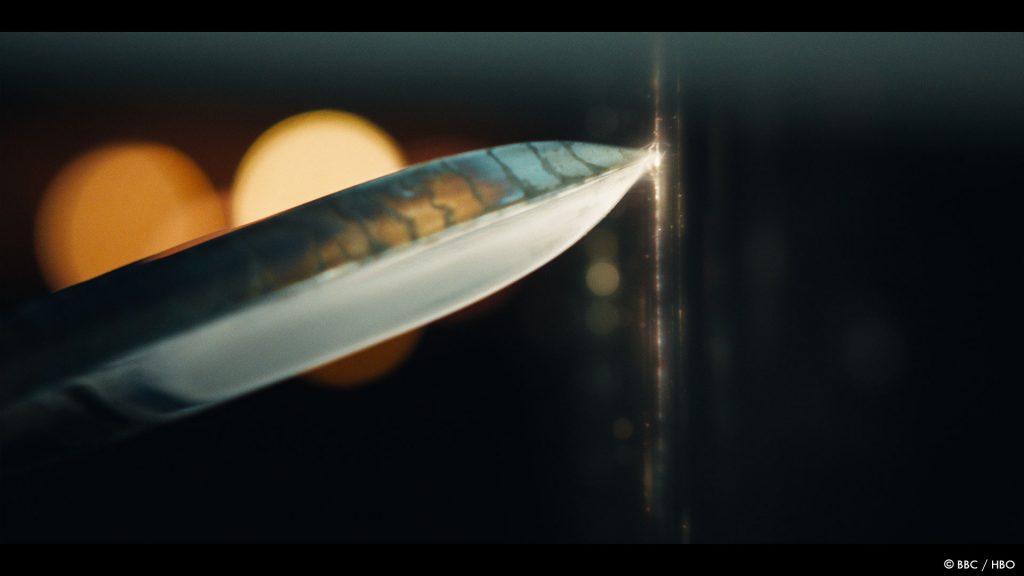
Let’s talk about the daemons. How did you enhance their models since the first season?
For our Season 1 animals we did very little to them as we were happy with the results and felt the budget was needed elsewhere. We put our daemon asset time and money into new characters. We built a Wolverine, Red Panda, Magpie, Osprey, Harris Hawk, Red Kite, Spider, Lemur and a Chinese pond Heron. Many of these assets were for hero sequences so needed to be of a high level.
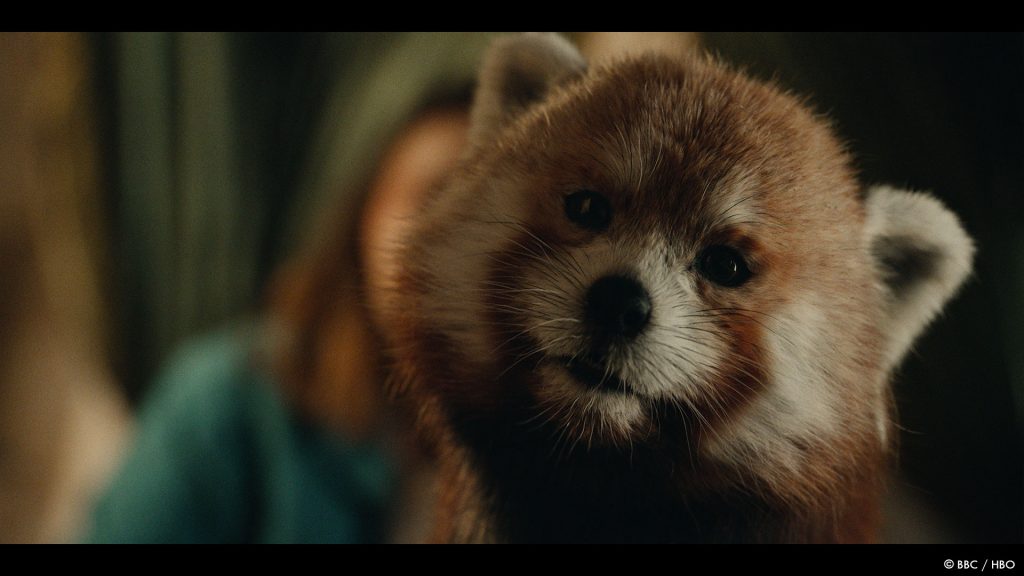
Which daemon was the most complicated to create and why?
The Chinese Pond Heron, that was my gift to the asset team! Birds themselves are particularly hard to create due to the combination of the way the wings fold and the ways the feathers interact when they go from one body shape to another. The Pond Heron threw in the additional challenge of a stretchy neck and strange fur like feathers. We are reserved when we execute the shots to try and work around the moments where wings fold up completely but there is no escaping the scene where the monkey attacks it, beats it up and then hands it over to an equally complex effects monster. If the team is reading this… I’m sorry.
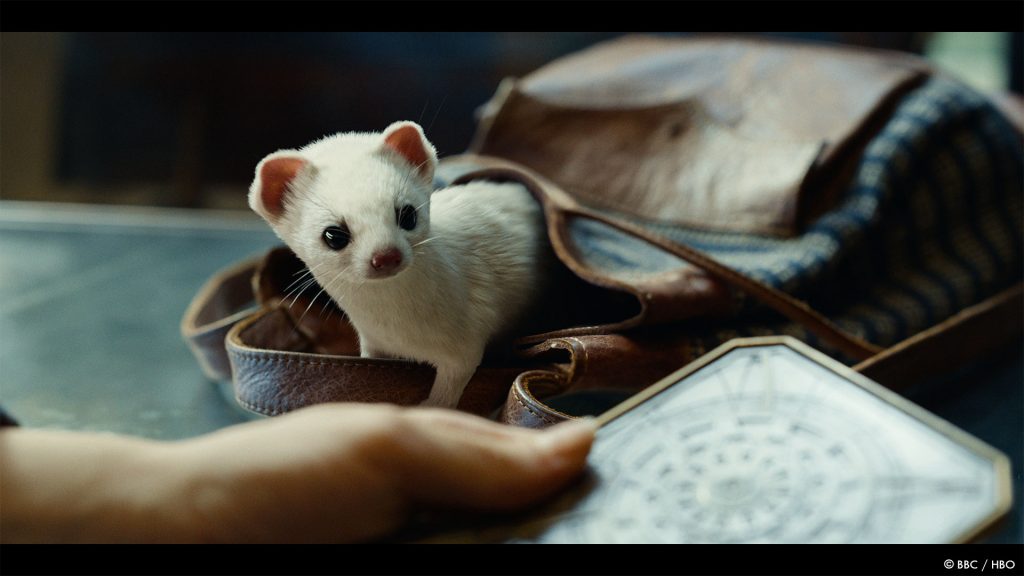
How did you used the previs and postvis for the sequences between the Witches and the Zeppelins?
I really like the back story behind the scene where the witches retaliate against the Magisterium and kill the airship crews before going through the anomaly to Cittagazze. Previously, we had a scene where the Magisterium bomb the witches and were going to have the witches fight back then. Dan May, Jamie Childs and the previs team dreamt up a really nice sequence but then we decided to lose that action beat. A little later we decided to have the witches retaliate in a later episode and Dan May and Jamie suggested that we rekindle the old blocking and fit it to the new scene, it was a cool idea in the first place and ended up even better with the new scene. It was also useful because we had a previs in place for it already.
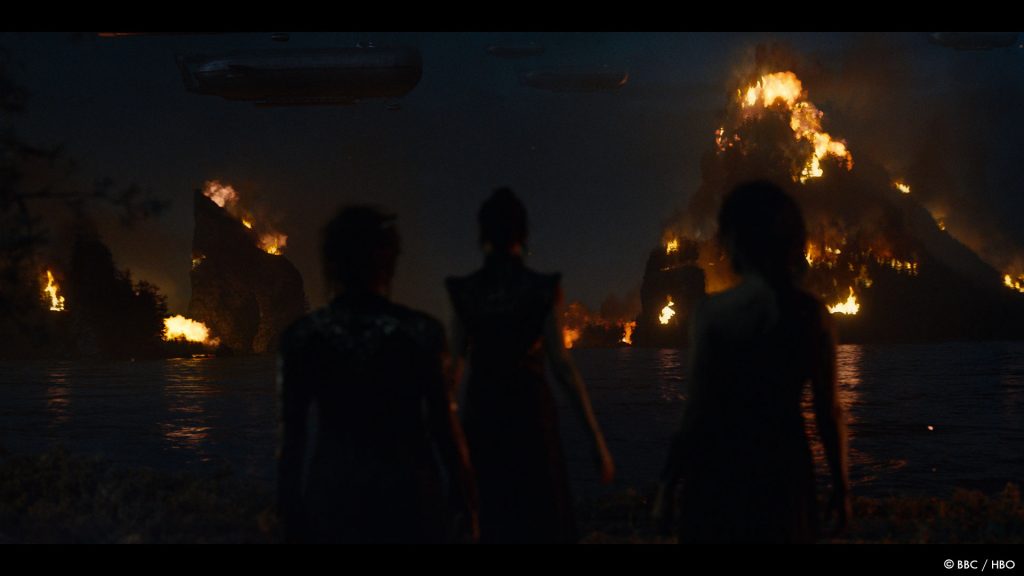
Can you explain in detail about the creation of these sequences?
When we do the witches “bamfing” (moving really quickly through a rush of particles) we try to shoot it as organically as possible. We develop the choreography with the stunts team and a double for the actress and then teach the actress the routine. We then shoot it with the actress stepping through as well as with the stunt team miming their deaths. We also scan and create high level digi doubles of the witches in costume. We then have all the pieces we need to make the witches appear and disappear, augment the body movements with cg but maintain the facial performances. The “bamf” effect is created in houdini and is art directed in each shot.
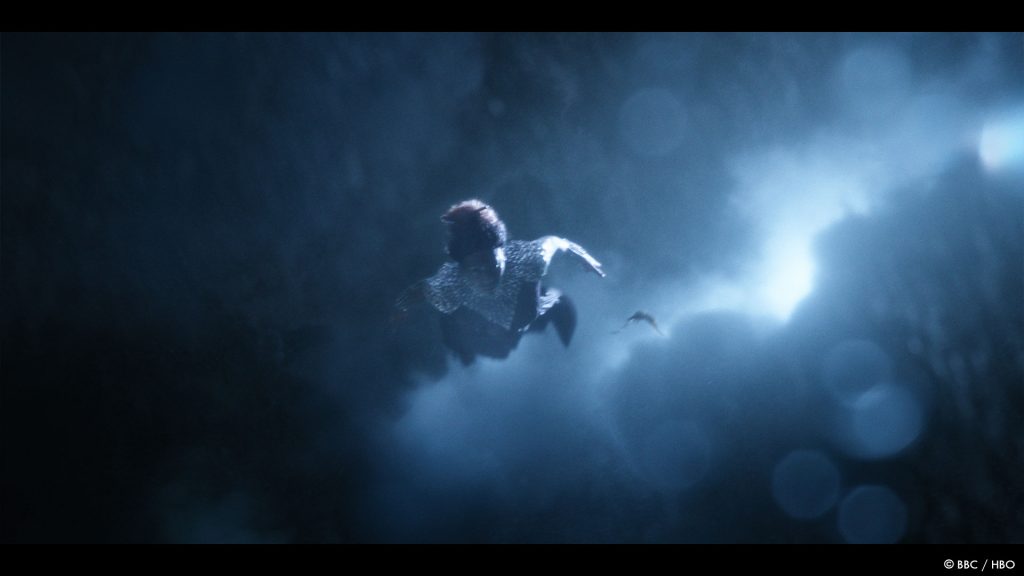
How did you manage so many FX elements for the storm and the ocean?
Our Montreal team did a killer job on this sequence. It was led by VFX Supervisor Stephane Naze and executed by a very talented team. The Painting Practice created a little sandbox in unreal with realtime cloud, storm and rain along with a pre animated witch flying through the scene. They parented a camera to the witch that you could then operate on top of it with a virtual camera in VR. We didn’t actually do much shot for shot previs but it allowed us and the director, Jamie Childs, to get a sense of the energy we were aiming for. The previs team also did some hybrid postvis where they did some traditional storyboarding on top of the renders. From this we ended up with some rushes to piece together and a few moments in particular that we liked. At Framestore VFX Supervisor Stephane Naze and his team picked this up and I briefed them again on the feeling of energy and pace whilst also referencing the previs work. The team in Montreal crafted a fully volumetric 3D cloud system with CG lightning and rain and we worked with our Montreal animation supervisor Fernando Lopes Herrera to get the right flow for witches movements and the cameras relative to them. Once this was done we worked to create a nice visual rhythm of positive and negative lighting, reveals behind clouds, rain on the lens etc. When we do this we also have sound design in mind as we can create opportunities for them in the mix.
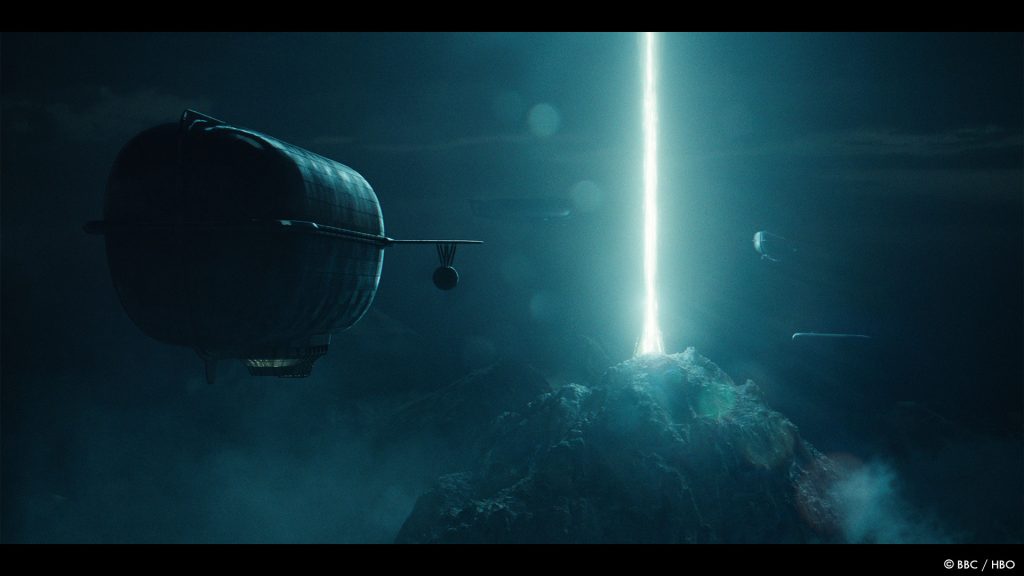
Which sequence or shot was the most challenging?
I think the sequence with Mrs.Coulter learning to control the Spectres was one of the most challenging. The creation of the Spectres alone was challenging as developing a creature that is predominantly simulated and follows very few traditional creature rules is always difficult, especially as the results can be unpredictable. Creating a lot of these Spectres and sitting them convincingly alongside Ruth Wilson’s performance was tricky. Rob Harrington and the team nailed it in the end though.
Another tricky type of shot was our set extensions when we are out in the Cittagazze countryside in episodes 6 and 7. We shot a lot of these scenes on a stretch of set that looked like a ravine bed in a crack in the ground. These cracks were part of Joel Collins’ (Production Designer) vision for the wider landscape. The hard thing here is that it is extremely difficult to achieve naturalistic exterior lighting on interior stage, especially with large sets. VFX Supervisor Christian Kaestner joined us for the last two episodes and really got deep into solving some of these environmental issues. This often involved doing large extensions and replacing spurious looking portions of the set that the light wasn’t falling quite right on.
Is there something specific that gives you some really short nights?
Whether the different teams would achieve the things I just described:)
What is your favorite shot or sequence?
It is extremely difficult to pick one in particular as each scene has so many good memories and challenges associated with it. I absolutely loved planning and shooting the Alethiometer Heist with Leanne Welham as it was a really collaborative experience and translated really well to the edit. I also really enjoyed the scenes that I 2nd Unit Directed as that is always an exciting process.
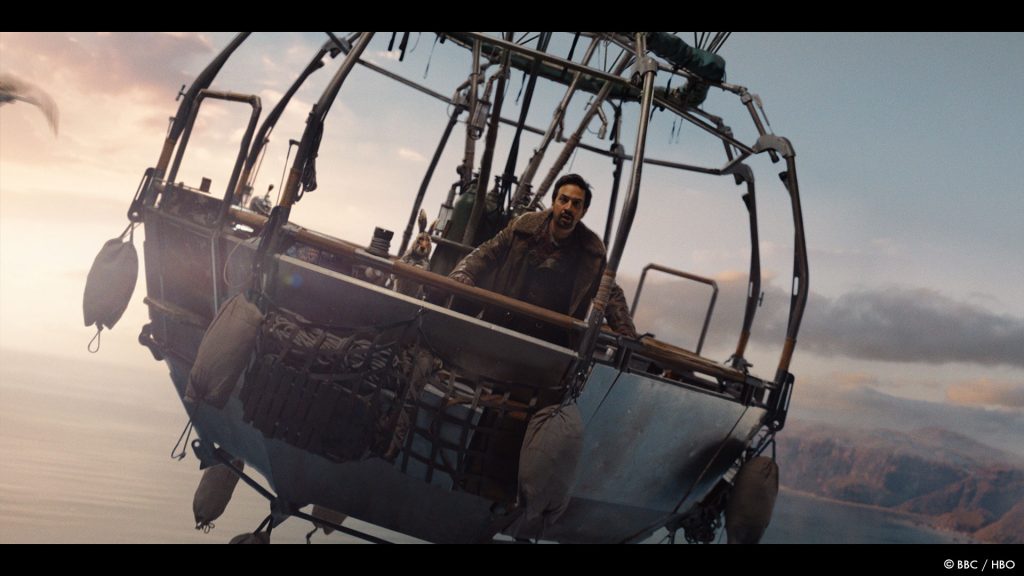
What is your best memory on this show?
Walking around the finished set of Cittagazze, Joel, Robyn and Dan did such an amazing job designing and building it and the end result felt really immersive.
How long have you worked on this show?
Right now I will be entering the 4th year on it.
What’s the VFX shots count?
Around 1400 shots.
What was the size of your team?
It’s tricky to be exact but around 450 artists at Framestore worked on the show across the sites.
What is your next project?
All being well we will finish the Trilogy with Season 3.
What are the four movies that gave you the passion for cinema?
I’m going to mix up movies and TV shows as both influenced me equally. Also I can’t possibly give you THE four but I can give you four that I love.
Friday Night Lights (The TV Show) – This show is amazing, brilliant personal, community drama.
The Life Of Brian – Because it opened my mind to a different type of comedy.
The Thin Red Line – Because it is a visual poem and has a really unique rhythm.
Die Hard – Because it’s Die Hard!
Also, strangely, no VFX movies.
A big thanks for your time.
WANT TO KNOW MORE?
Framestore: Dedicated page about His Dark Materials on Framestore website.
© Vincent Frei – The Art of VFX – 2021
Be sure to watch this excellent live action trailer with the VFX work made by Platige Image for the game, The Medium:
WANT TO KNOW MORE?
Platige Image: In-depth presentation about the creation and shooting of the live action trailer.
© Vincent Frei – The Art of VFX – 2021